Today the year 2020 comes to an end. I think that everyone would agree it has been a year that we will never forget but a year the likes of which we hope to never see again.
Earlier this morning I was looking at some of my old blog posts from the past year. On December 31st of 2019 I bemoaned the sorry political state of the U.S., but I was looking forward to my long winter stay in Mexico City during January and February. Little did I know that the trip would be the last one that I would take for over a year. I read with nostalgia some of the posts from that trip... descriptions of meals that I enjoyed, special exhibits at the museums, some new places I discovered in the city, and a couple of delightful weekend excursions outside of the city with Alejandro. In late January I went to Mexico City's Chinatown for the celebration of the Chinese New Year. I made no mention in the blog of the virus in Wuhan, China, that was being reported in the news. Alejandro joked that I would catch the "corona" when I visited Chinatown. In retrospect, the joke now seems tasteless, but we had no idea at that point how the virus was going to impact the entire world.
When I returned home on February 20th I was already looking forward to my return to Mexico in April in time for Easter and Alejandro's birthday. I did my shopping for birthday presents as well as for plastic eggs and wrapped candy so that Alejandro's nephew Ezra could have an Easter egg hunt. The virus had by that time entered both the U.S. and Mexico but the cases were so few that I was not really thinking of the need to cancel my trip. By mid-March, it was a pandemic. Schools, restaurants and bars were closed here in Ohio, and even a trip to the grocery store seemed a bit risky. I rescheduled my April flight... and later rescheduled the trips that I would normally take in August and October.
And so we went through the year living in an alternate reality in which everything had changed. The death toll climbed, and the economy was battered while a vocal group of idiots within the government and in the general populace proclaimed that it was all a hoax and that wearing masks was an infringement of liberty. Indeed, as we went through the spring, summer and early fall, the virus was something I read about in the news. I did not personally know anyone who had contracted COVID. Then after Thanksgiving, as the numbers exploded, it seemed that every day I heard of someone who had tested positive... including some loved ones who fortunately have since recovered. Mexico has been hard hit also. Alejandro knows of at least twelve people in his "colonia" or neighborhood who have died of the virus.
Set against the pandemic we went through the most exhausting, bizarre, vitriolic and seemingly endless Presidential campaign in my memory. And we continue to be exhausted by the sore losers and petulant babies who continue to make claims of voter fraud and who would shred our Constitution even after conservative judges have dismissed their claims as baseless fantasy. January 20th can not come soon enough for me.
In spite of the immense tragedy that has been suffered by so many, there have been for me some silver linings in this pandemic. During this prolonged period of staying at home I have had some much needed renovations to my house done. Unable to travel internationally, I have done some "local tourism", exploring some places close to home that I had not seen before, I have done quite a bit of experimenting in the kitchen. Some of my experiments have even been successful, and I have more choices when I ask myself, "What shall I make for dinner?" And I have done a lot of chatting on Skype with my cousins in Europe. I feel as if we have grown much closer than when our contact was mainly through my occasional trips across the "pond". Even after the pandemic is over, I hope that we will continue to have our frequent video chats.
As the new year approaches, there is light ahead of us with vaccines for the virus and a new President. Yes, there will be some more grim months in which COVID continues to rage across the globe, and, no, the poisonous divisiveness in U.S. politics is not going to disappear overnight. But at midnight tonight I will open the front door, ring my great-grandmother's dinner bell, and hope for a better 2021!




















































